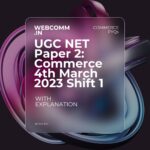The correct answer is Assurance .
 Key PointsThe knowledge and courtesy of employees and their ability to convey trust and confidence indicate the level of Customer Service Quality. This is a critical aspect of a business's operations as it directly impacts customer satisfaction and loyalty.
Key PointsThe knowledge and courtesy of employees and their ability to convey trust and confidence indicate the level of Customer Service Quality. This is a critical aspect of a business's operations as it directly impacts customer satisfaction and loyalty.
 Important Points
Important Points
- Assurance is one of the five dimensions of service quality identified in the SERVQUAL model, a widely used framework for evaluating service quality.
- It focuses on the knowledge, courtesy, and trustworthiness of service providers and their ability to convey confidence to customers.
Components of Assurance -
- Knowledge - This involves the skills, expertise, and information possessed by employees. They should be well-trained and knowledgeable about the products or services they are providing.
- Courtesy - This refers to the politeness, respect, and consideration shown by employees towards customers. It involves treating customers with dignity and showing good manners.
- Trust and Confidence - Customers should feel that they can trust the employees to deliver on their promises. This involves being reliable, dependable, and consistent in providing quality service.
Importance of Assurance - Assurance is critical in building customer confidence and loyalty. When customers have confidence in the employees' knowledge and abilities, they are more likely to trust the organization and become repeat customers.
In summary, assurance is about instilling confidence in customers through the knowledge, courtesy, trustworthiness, and competence of employees. It's a crucial aspect of service quality and contributes significantly to building strong customer relationships.
The correct answer is Assurance .
 Key PointsThe knowledge and courtesy of employees and their ability to convey trust and confidence indicate the level of Customer Service Quality. This is a critical aspect of a business's operations as it directly impacts customer satisfaction and loyalty.
Key PointsThe knowledge and courtesy of employees and their ability to convey trust and confidence indicate the level of Customer Service Quality. This is a critical aspect of a business's operations as it directly impacts customer satisfaction and loyalty.
 Important Points
Important Points
- Assurance is one of the five dimensions of service quality identified in the SERVQUAL model, a widely used framework for evaluating service quality.
- It focuses on the knowledge, courtesy, and trustworthiness of service providers and their ability to convey confidence to customers.
Components of Assurance -
- Knowledge - This involves the skills, expertise, and information possessed by employees. They should be well-trained and knowledgeable about the products or services they are providing.
- Courtesy - This refers to the politeness, respect, and consideration shown by employees towards customers. It involves treating customers with dignity and showing good manners.
- Trust and Confidence - Customers should feel that they can trust the employees to deliver on their promises. This involves being reliable, dependable, and consistent in providing quality service.
Importance of Assurance - Assurance is critical in building customer confidence and loyalty. When customers have confidence in the employees' knowledge and abilities, they are more likely to trust the organization and become repeat customers.
In summary, assurance is about instilling confidence in customers through the knowledge, courtesy, trustworthiness, and competence of employees. It's a crucial aspect of service quality and contributes significantly to building strong customer relationships.




Thanks for this paper